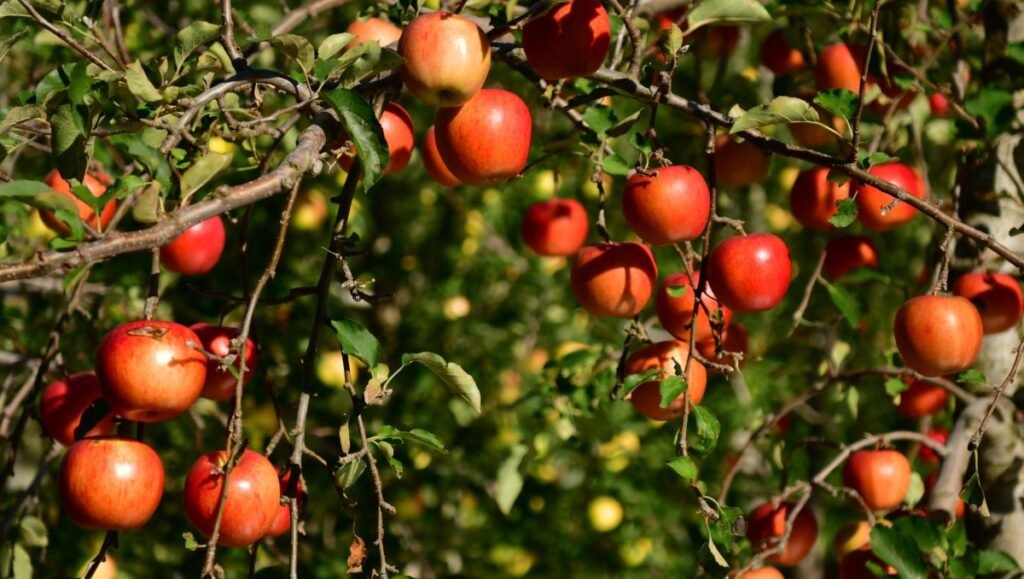This post contains affiliate links. See the affiliate disclaimer here.
Japan is a country that is rich in culture, history, and nature. One of the aspects of Japanese culture that attracts many visitors is its cuisine, which is diverse, healthy, and delicious. Among the many ingredients that make up Japanese cuisine, fruits are especially important.
Fruits are not only eaten as desserts or snacks, but also used in various dishes, drinks, and sweets. Fruits are also valued for their symbolic meanings, such as longevity, prosperity, and happiness.
In this article, we will introduce you to some of the most common and unique fruits that you can find in Japan and their names in Japanese. We will also explain how to pronounce them, how to write them in different scripts, and what they mean in Japanese culture.

Common Fruit Names in Japanese
Many of the fruits that are popular in Japan are also familiar to people around the world, such as apples, bananas, oranges, and strawberries. However, some of them may have different names or varieties in Japan. Here are some of the common fruit names in Japanese, along with their pronunciation, writing, and meaning.
- りんご (ringo) — Apple
- Katakana: リンゴ
- Kanji: 林檎
- Pronunciation: [ɾiŋɡo]
- Meaning: Apples are one of the most widely consumed fruits in Japan, and they come in many varieties, such as Fuji, Tsugaru, and Jonagold. Apples are often given as gifts or offerings, as they symbolize health, beauty, and harmony.
- あんず (anzu) — Apricot
- Katakana: アンズ
- Kanji: 杏
- Pronunciation: [aɴzɯ]
- Meaning: Apricots are not very common in Japan, but they are sometimes used to make jams, preserves, or liqueurs. Apricots are also associated with the Japanese apricot tree, or ume, which is a symbol of spring, elegance, and perseverance.
- バナナ (banana) — Banana
- Pronunciation: [banaɴa]
- Meaning: Bananas are a popular tropical fruit that is imported from countries like the Philippines, Ecuador, and Colombia. Bananas are often eaten as a snack, or used in desserts, smoothies, or cakes. Bananas are also considered to be a good source of energy, potassium, and fiber.
- ブルーベリー (buruuberii) — Blueberry
- Pronunciation: [bɯɾɯːbeɾiː]
- Meaning: Blueberries are a relatively new fruit in Japan, but they have become more popular in recent years, thanks to their health benefits and antioxidant properties. Blueberries are often eaten fresh, or used in jams, pies, muffins, or yogurt. Blueberries are also said to improve eyesight, memory, and brain function.
- さくらんぼ (sakuranbo) — Cherry
- Katakana: サクランボ
- Kanji: 桜桃 or 桜ん坊
- Pronunciation: [sakɯɾaɴbo]
- Meaning: Cherries are a seasonal fruit that are harvested in early summer, and they are usually sweet and juicy. Cherries are often eaten fresh, or used in desserts, drinks, or preserves. Cherries are also related to the cherry blossom, or sakura, which is the national flower of Japan and a symbol of beauty, transience, and renewal.
- ココナッツ (kokonattsu) — Coconut
- Pronunciation: [kokoɴaʦɯ]
- Meaning: Coconuts are another tropical fruit that are imported from countries like Thailand, Indonesia, and Malaysia. Coconuts are often used to make coconut milk, cream, oil, or water, which are used in various dishes, drinks, or cosmetics. Coconuts are also known for their high nutritional value, as they contain healthy fats, minerals, and vitamins.
- ぶどう (budou) — Grape
- Katakana: ブドウ
- Kanji: 葡萄
- Pronunciation: [bɯdoː]
- Meaning: Grapes are a popular fruit that are cultivated in many regions of Japan, such as Yamanashi, Nagano, and Okayama. Grapes are often eaten fresh, or used to make wine, juice, jelly, or vinegar. Grapes are also a symbol of abundance, fertility, and prosperity.
- キウイ (kiui) — Kiwi
- Pronunciation: [kiɯi]
- Meaning: Kiwis are a small, green, fuzzy fruit that are native to New Zealand, but are also grown in Japan, especially in Ehime and Wakayama prefectures. Kiwis are often eaten fresh, or used in salads, desserts, or smoothies. Kiwis are also rich in vitamin C, fiber, and antioxidants.
- レモン (remon) — Lemon
- Kanji: 檸檬
- Pronunciation: [ɾemoɴ]
- Meaning: Lemons are a citrus fruit that are widely used in Japan, both as a food and as a medicine. Lemons are often used to add flavor, acidity, or aroma to dishes, drinks, or sweets. Lemons are also valued for their antibacterial, antiseptic, and anti-inflammatory properties, as well as their vitamin C content.
- びわ (biwa) — Loquat
- Katakana: ビワ
- Kanji: 枇杷
- Pronunciation: [biwa]
- Meaning: Loquats are a yellow, oval-shaped fruit that are native to China, but are also grown in Japan, especially in Shizuoka and Nagasaki prefectures. Loquats are often eaten fresh, or used to make jams, syrups, or liqueurs. Loquats are also believed to have various health benefits, such as soothing the throat, improving digestion, and lowering blood pressure.
- マンゴー (mangoo) — Mango
- Pronunciation: [maŋɡoː]
- Meaning: Mangos are a tropical fruit that are imported from countries like India, Thailand, and the Philippines, but are also grown in Japan, especially in Okinawa and Miyazaki prefectures. Mangos are often eaten fresh, or used in desserts, drinks, or curries. Mangos are also known for their sweet, juicy, and fragrant flesh, as well as their vitamin A and C content.
- メロン (meron) — Melon
- Pronunciation: [meɾoɴ]
- Meaning: Melons are a type of fruit that belong to the gourd family, and they come in many varieties, such as watermelon, cantaloupe, honeydew, and muskmelon. Melons are often eaten fresh, or used in desserts, drinks, or salads. Melons are also considered to be a luxury item in Japan, as they can be very expensive and are often given as gifts or prizes.
- オレンジ (orenji) — Orange
- Pronunciation: [oɾeɴdʑi]
- Meaning: Oranges are a citrus fruit that are widely consumed in Japan, both as a fresh fruit and as a juice. Oranges are often used to make marmalade, candied peel, or liqueur. Oranges are also a good source of vitamin C, folate, and fiber, and they are said to boost the immune system, prevent scurvy, and improve skin health.
- もも (momo) — Peach
- Katakana: モモ
- Kanji: 桃
- Pronunciation: [momo]
- Meaning: Peaches are a soft, pink, fuzzy fruit that are native to China, but are also grown in Japan, especially in Yamanashi and Fukushima prefectures. Peaches are often eaten fresh, or used to make jams, pies, or ice cream. Peaches are also a symbol of longevity, femininity, and romance, and they are associated with the Peach Boy legend, or Momotaro.
- なし (nashi) — Pear
- Katakana: ナシ
- Kanji: 梨
- Pronunciation: [naɕi]
- Meaning: Pears are a crunchy, juicy, and sweet fruit that are native to Asia, but are also grown in Japan, especially in Chiba and Tottori prefectures. Pears are often eaten fresh, or used to make juice, wine, or vinegar. Pears are also a symbol of autumn, grace, and purity, and they are said to have a cooling effect on the body.
- かき (kaki) — Persimmon
- Katakana: カキ
- Kanji: 柿
- Pronunciation: [kaki]
- Meaning: Persimmons are a bright orange, round fruit that are native to Japan, and they are one of the most iconic fruits of the country. Persimmons
Other Fruits
Japan is renowned for its exquisite and diverse culinary traditions. Among the numerous delights that Japanese cuisine has to offer, fruits hold a special place. With an array of unique flavors, textures, and colors, Japanese fruits are appreciated not only for their taste but also for the cultural significance they carry.
- Yūba:
Yūba, known as “thin soy skin” in English, is a delicate delicacy made from soy milk. Though not a fruit itself, it is named after the fruit it closely resembles: the yuzu. Yūba is often served as a wrap or a topping for various dishes, adding a subtle and refreshing taste to the overall experience. - Yuzu:
Yuzu is a prized citrus fruit, resembling a small grapefruit but with a unique, aromatic flavor. Its tangy zest is used to enhance numerous dishes, sauces, and desserts, providing a distinct citrusy taste. The name “yuzu” likely originated from the combination of two words — “yu,” meaning “hot water,” and “zu,” meaning “relish.” This reflects its prominent use in traditional yuzu-yu baths, believed to promote relaxation and improve circulation during the winter season. - Mikan:
Mikan, often hailed as the king of Japanese fruits, is a type of mandarin orange. With its bright orange color, it is consumed abundantly during the winter months. The name “mikan” simply translates to “mandarin orange” in Japanese and signifies the fruit’s widespread popularity and recognition across the country. - Nashi:
Known as the Japanese pear, nashi is a crisp and juicy fruit with a texture resembling that of an apple. Its name stems from the Japanese word “nashi,” meaning “Japanese pear tree,” highlighting its connection to traditional agriculture and orchard farming practices. - Ichijiku:
Ichijiku, commonly referred to as “fig” in English, had its name derived from the Chinese characters for “one” and “day.” This references the short shelf life of the fruit, which must be harvested and consumed as soon as it ripens to enjoy its sweet and luscious flavor. - Sudachi:
Sudachi is a small, green citrus fruit featuring a tart and tangy taste. Its name is derived from “suda,” which means “vinegar,” emphasizing its frequent use as a condiment or flavoring agent in various dishes, drinks, and sauces. Sudachi is particularly revered in the cuisine of the Tokushima Prefecture. - Kyoho:
Kyoho grapes are large, dark-purple grapes with a rich and juicy flavor. The name “Kyoho” refers to an ancient era in Japan and translates to “giant mountain grapes.” The fruit acquired this name due to its impressive size, resembling the grandeur of mountains.
Conclusion:
The names of Japanese fruits not only describe their characteristics but also reveal the deeper cultural connections and unique traits associated with each fruit. From the tangy zest of yuzu to the juicy crunch of nashi, these fruits have become an integral part of Japanese cuisine.
Exploring their names allows us to appreciate the rich tapestry of Japanese culinary traditions and the significance attached to each fruit’s distinctive properties.

